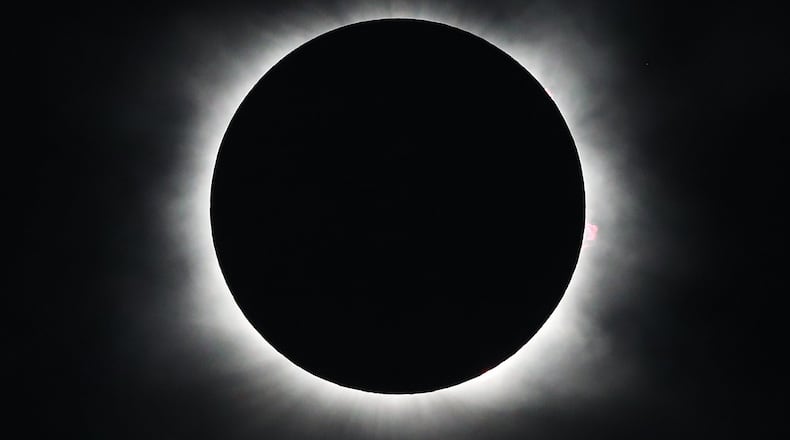Monday was a big day for amateur astronomers and umbraphiles.
It was also a good time for basic science. Georgia Tech electrical engineering professor Morris Cohen ran an experiment Monday that linked the astronomical, the esoteric and the practical.
His work took him to the middle of a softball field in a rolling, 122-acre Jewish summer camp/event facility called Ramah Darom, a green and pleasant spot in Rabun County that happened to be on the line of totality.
There Cohen sent a weather balloon aloft with a payload of instruments to get a bird's-eye view of the moon's shadow as it raced eastward. In the meantime, he was also collecting information from listening stations around the country as they measured the scattering of low frequency radio waves, bouncing off this peculiar temporary blackness.
In a nutshell, Cohen wants to use radio waves to examine the ionosphere, with the goal of replacing or supplementing our vulnerable global positioning system.
Before GPS, low frequency radio waves served as a kind of GPS called Omega. Omega wasn’t precise, partly because “we didn’t understand the upper atmosphere,” Cohen said.
The eclipse offered an unusual window into that region. Here's why: The ionosphere is created when the sun's radiation shatters molecules at high altitude. Radio waves bounce off this layer and come back to Earth, though they travel higher at night before they bounce.
The eclipse creates a temporary instant night, with a sharp border. Collecting information on their behavior during the event should help scientists know the upper atmosphere better.
For that reason, Cohen, 36, brought his gear early to Rabun County, and offered a few well-attended classes at Ramah Darom in the days leading up to the eclipse, to explain what he and his graduate students were up to.
You can see a more detailed explanation here.
The Tech crew inflated the 8-foot balloon as the moon was making its transit, releasing it about a half hour before totality. Hanging below the balloon was a package of measuring equipment, duct-taped into a small Styrofoam cooler. The balloon slowly disappeared into the darkening sky, rising to 100,000 feet, shooting 360-degree video all the while. The balloon was expected to explode, and a parachute would lower the cameras and other gear back to the ground many miles away. A chase crew, leaving from a location in North Carolina, tracked it down, but as of Tuesday afternoon, it was stuck in a tree.
“They will go back soon and retrieve it,” Cohen said Tuesday. “The property owner is very friendly.”
Cohen’s students have used weather balloons before, successfully retrieving the black box each time. Some have flown 200 miles, though this one actually landed close to Rabun County, said former grad student Kimo Ocanas, 34, now an engineer at Northrop Grumman, who returned to help Cohen with the event.
Most of Monday’s several hundred visitors came to Ramah Darom for the spectacle, but Ocanas and others were attracted by the science.
David Baron, author of “American Eclipse,” writes that the eclipse of 1878 attracted scientists from around the country and in some ways helped the nation heal the wounds of the Civil War. “It reminds us that our differences are tiny compared to what we have in common,” he told CNN, “and I think it’s exactly what we need right now.”
Rafael Harpaz, 64, a medical epidemiologist at the Centers for Disease Control and Prevention, stood on the softball field and watched Cohen at work, and echoed Baron’s words. “I don’t know if an eclipse can bring us together,” he said as the sun was whittled down to a fingernail, “but the antifa and the alt-right are both going to be looking at the same sun.”
There are practical dividends from Cohen’s research, which was among several eclipse-related projects supported by grants from the National Science Foundation. Low frequency radio waves could be fashioned into a newer, more accurate and less vulnerable GPS. There are also intangible payoffs as he interacts with an interested public, explaining his work, answering wild questions, veering off into discussions of lightning and solar flares.
C. Alex Young, a heliophysicist with NASA, said this kind of interaction is the tonic for a strong scientific ecology. He offered an analogy: “Not everybody can be an artist, but lots of people can appreciate a good painting,” he said.
He wanted to see people excited by science. “I’m hoping there will be people with goose bumps all over the country.”
About the Author
Keep Reading
The Latest
Featured






